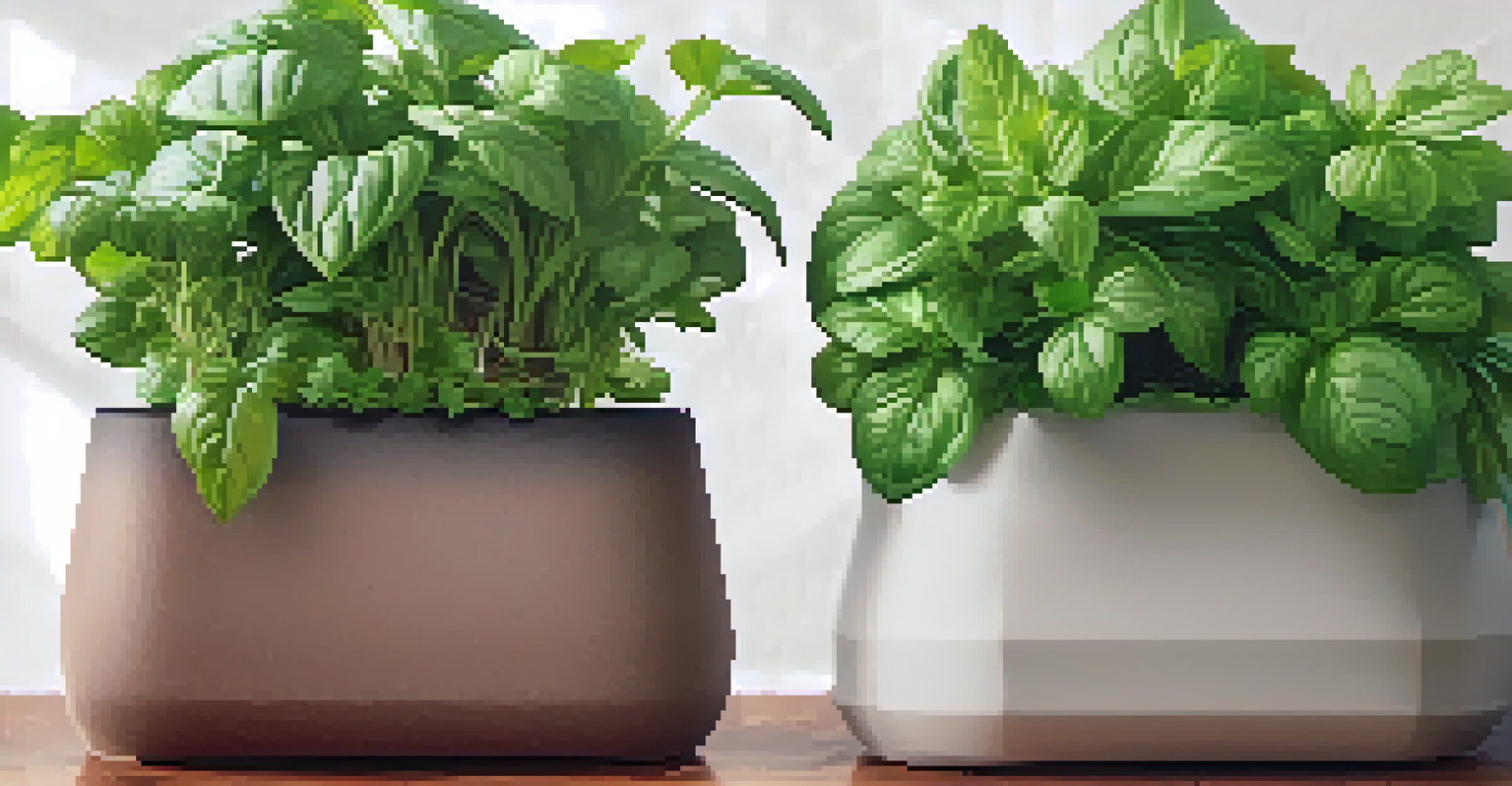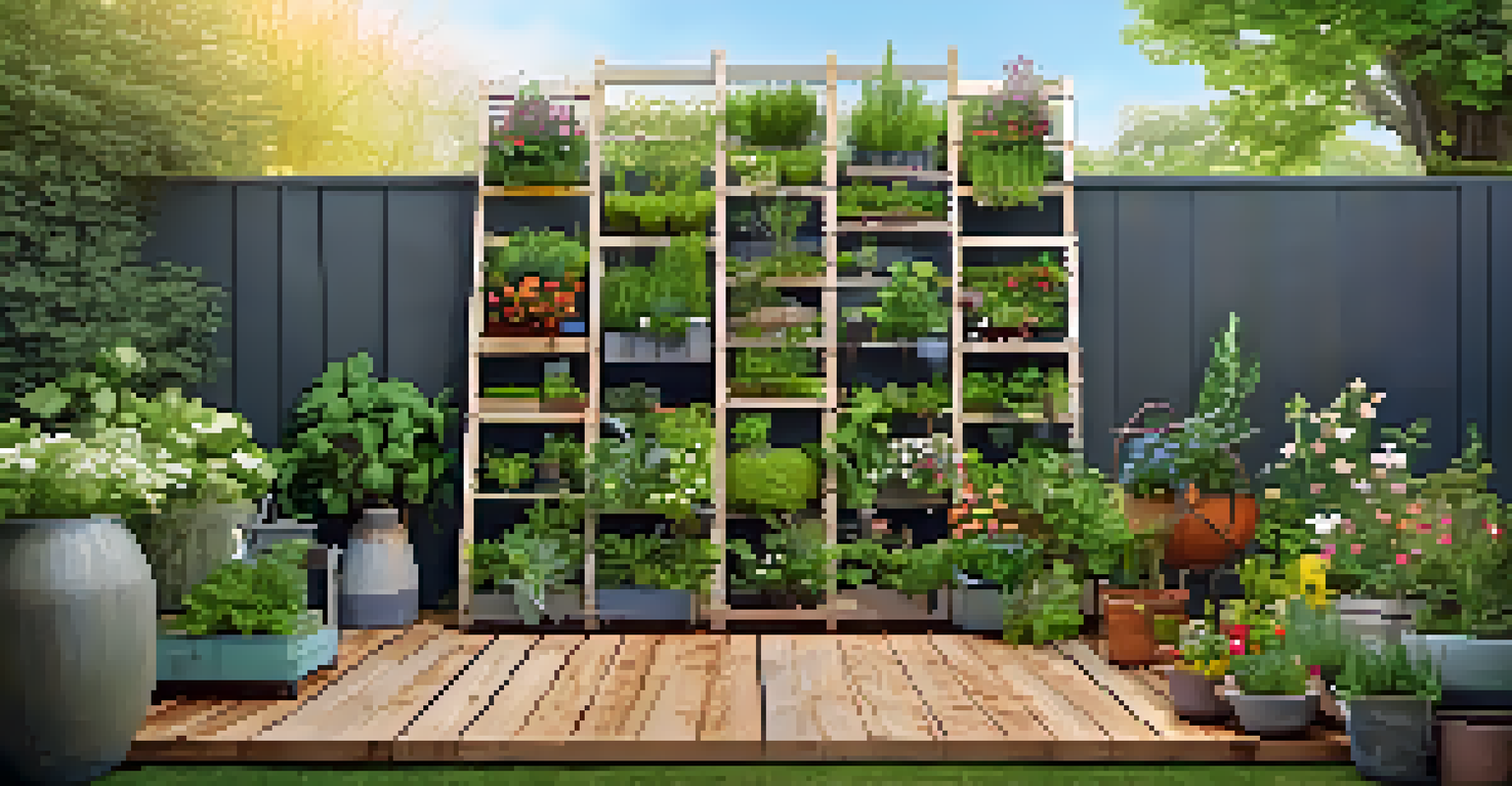Vertical Gardening: Maximizing Space with Innovative Techniques

Understanding Vertical Gardening and Its Benefits
Vertical gardening is the practice of growing plants upward instead of outward. This innovative approach is perfect for urban dwellers with limited space, allowing you to cultivate a lush garden even on a small balcony or patio. By utilizing vertical space, gardeners can increase their yield without needing more ground area.
Gardening is a way of showing that you believe in tomorrow.
One of the key benefits of vertical gardening is improved air circulation and sunlight exposure. Plants grown vertically can receive more light, which is particularly beneficial for those in shaded areas. This not only enhances growth but also helps reduce the risk of diseases that thrive in stagnant conditions.
Additionally, vertical gardens can serve as beautiful living walls, adding aesthetic value to your home. They can transform bare walls into vibrant green spaces, providing a calming atmosphere while also helping to improve air quality. With such a range of benefits, it's no wonder vertical gardening is gaining popularity among modern gardeners.
Choosing the Right Plants for Vertical Gardens
Selecting the right plants is crucial for a successful vertical garden. Opt for varieties that thrive in confined spaces and have the ability to grow upwards. Herbs like basil and mint, as well as vining plants like tomatoes and cucumbers, are excellent choices for vertical gardening due to their growth habits.

Consider the climate and sunlight conditions of your space when choosing plants. Some plants prefer full sun, while others thrive in partial shade. Understanding your local climate will help you select plants that will flourish in your vertical garden, ensuring a bountiful harvest.
Space Efficiency in Gardening
Vertical gardening allows urban dwellers to maximize limited space by growing plants upward.
Don't forget about aesthetics! Mixing different colors, textures, and types of plants can create a visually appealing garden. For instance, combining trailing plants with upright varieties can create a stunning display that’s as pleasing to the eye as it is productive.
Innovative Structures for Vertical Gardening
The structure of your vertical garden can vary widely, depending on your space and creativity. You can use simple solutions like wall-mounted planters or more elaborate systems like trellises and vertical frames. These structures not only support plant growth but also add character to your garden.
The best time to plant a tree was twenty years ago. The second best time is now.
Repurposed materials are a fantastic option for building your vertical garden. Old pallets, ladders, or even shoe organizers can be transformed into functional planting areas. This eco-friendly approach not only saves money but also allows you to express your personal style in your garden.
It's essential to ensure that whatever structure you choose provides adequate support and drainage. Plants can become heavy as they grow, so sturdiness is key. Additionally, ensuring that your setup allows for proper water drainage will help prevent root rot and keep your plants healthy.
Watering Techniques for Vertical Gardens
Watering can be a challenge in vertical gardens due to their unique structure. It's important to use methods that ensure even moisture distribution throughout the plants. Drip irrigation systems are a popular choice, delivering water directly to the roots without the risk of over-saturating the soil.
Another effective technique is using self-watering containers, which can help maintain consistent moisture levels. These containers have a reservoir at the bottom that allows plants to absorb water as needed, reducing the frequency of watering and making maintenance easier.
Plant Selection is Key
Choosing the right plants that thrive in confined spaces is crucial for a successful vertical garden.
Always monitor your plants for signs of drought or overwatering. Since vertical gardens may dry out faster than traditional gardens, keeping an eye on moisture levels is essential. A simple moisture meter can help you ensure your plants are receiving just the right amount of water.
Nutrient Management in Vertical Gardens
Nutrient management is crucial for the success of your vertical garden. Since plants are often growing in limited soil, they can quickly deplete available nutrients. Regularly adding organic fertilizers can help replenish these nutrients and promote healthy plant growth.
Consider using slow-release fertilizers or organic compost, which can provide a steady supply of nutrients over time. This method not only supports plant health but also reduces the risk of over-fertilization, which can harm your plants.
Additionally, incorporating companion planting can enhance nutrient uptake. By planting certain species together, you can create a symbiotic relationship that benefits all plants involved, leading to a more robust and productive vertical garden.
Pest Management Strategies for Vertical Gardens
Pests can be a concern in any garden, including vertical ones. Regular monitoring is essential to catch any infestations early. Inspecting your plants for signs of pests, such as holes in the leaves or unusual spots, can help you address issues before they escalate.
Utilizing natural pest control methods is often the best approach. Introducing beneficial insects like ladybugs can help keep harmful pests at bay. Additionally, using organic sprays made from neem oil or insecticidal soap can effectively target pests without harming your plants.
Sustainable Gardening Practices
Incorporating native plants and composting can enhance the sustainability of your vertical gardening efforts.
Creating a diverse planting scheme can also deter pests. By mixing different species, you can confuse pests and reduce the likelihood of infestations. A well-maintained vertical garden can be both a beautiful sight and a thriving ecosystem.
Creating a Sustainable Vertical Garden
Sustainability is a key consideration in modern gardening practices, and vertical gardening is no exception. Using native plants can significantly reduce the need for additional resources, as these plants are well-adapted to local conditions. They often require less water and are more resistant to pests.
Implementing composting practices can also enhance sustainability. By recycling kitchen scraps and garden waste, you can create nutrient-rich compost that nourishes your vertical garden. This not only reduces waste but also supports a healthy growing environment.

Lastly, consider the environmental impact of your gardening materials. Opting for sustainable, eco-friendly materials can minimize your carbon footprint. From organic soils to recyclable planters, making conscious choices can lead to a more sustainable gardening practice.